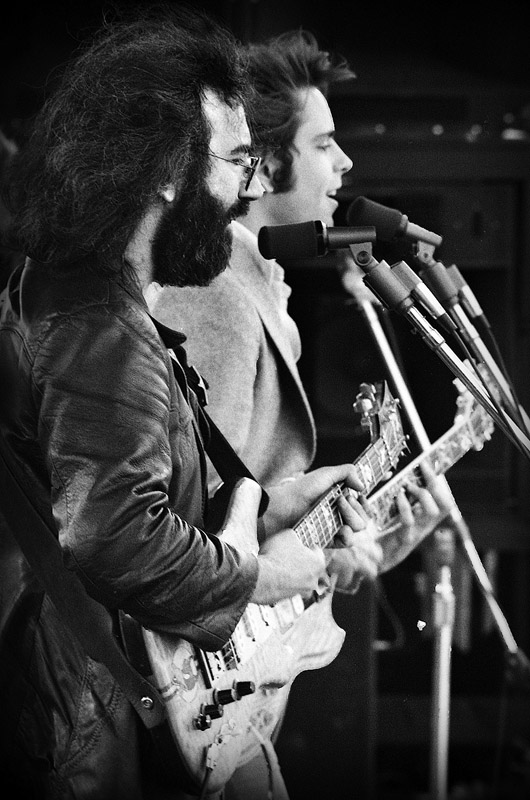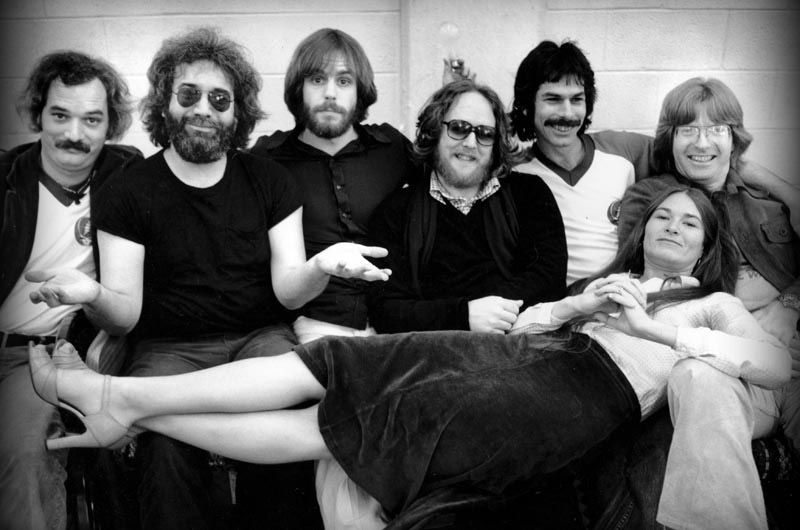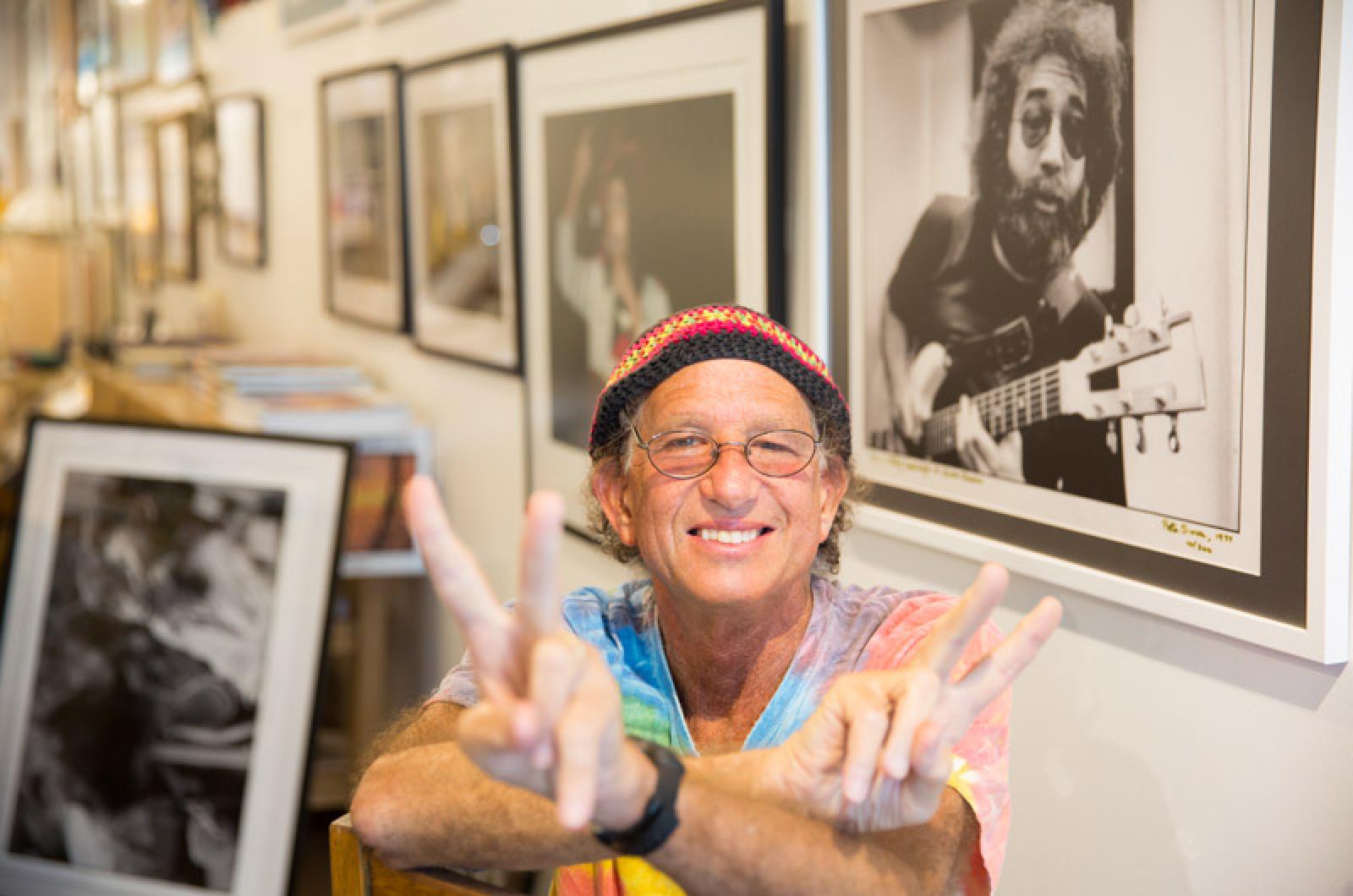If you have been a rock and roll photographer for 50 or so years, as Peter Simon has been, you have a lot of, well, rock and roll photographs lying around — in books and magazines, on the walls, in computers, file cabinets, boxes. And in Mr. Simon’s case, he also has a treasure trove of interviews, having hosted a weekly radio show called Good Vibrations from 1973 to 1977 on WVOI, the precursor to radio station WMVY.
The problem is keeping track of it all. For example, if Mr. Simon was looking for a certain interview he did with Jerry Garcia back in May of 1975, it could be anywhere.
“I knew I had done it but didn’t know where it was,” Mr. Simon said recently in his gallery in Vineyard Haven.
Underneath a pile of tie-dyed T-shirts? Nope. Behind the lava lamp? No again. In a box with a stack of photographs from his years of living in a commune in Vermont? (Nude farming anyone? This was the 1970s, after all.) Again, nothing.

And then there it was, the holy grail, tucked away on a shelf — the 10-inch reel to reel tape of the hourlong interview Mr. Simon had conducted with Jerry Garcia during a unique period in the group’s existence. The Grateful Dead had recently stopped touring and were trying to figure out what they would do and become next.
Mr. Simon had been on assignment for Rolling Stone magazine in March of 1975 to shoot a benefit concert called Snack Sunday (Students Need Activities, Culture and Kicks) held at Kezar Stadium in California. Many of the major musical acts of the day were performing there to raise money for the San Francisco public school system so kids could continue after-school sports programs and extracurricular activities.
After taking some pictures of the Grateful Dead, and Jerry Garcia in particular, Mr. Simon asked Jerry if he would sit down for an interview for the radio show. Jerry said sure, no problem.
It was a different time then. No publicists to go through, and very little filter or distance between fans and the famous. And in 1975 Jerry Garcia was very famous.
A few weeks ago Mr. Simon gave a copy of the recently discovered interview to MVY radio; earlier this week the station aired some of it as part of a fundraising campaign that includes a giveaway on Tuesday of one of Mr. Simon’s photographs of the Grateful Dead. On Saturday at noon the station will do a longer special to commemorate the anniversary of Mr. Garcia’s death on August 9, 1995.
Mr. Simon still remembers how excited he was at the chance to do the interview. But listening to it these days, he is both aghast at how unprofessional he sounds as an interviewer and amazed “at how gracious and humble and articulate Jerry Garcia was at that point in his life.”
In the interview, the two men quickly head out on a conversational tour of Jerry’s creative roots, his career crossroads and the movie the group was editing of five shows performed the year before at the Winterland Ballroom in San Francisco.
In addition to his questions, Mr. Simon enters the scene with some groovys, dig its and far outs, as would be expected of the era. Otherwise, the interview does not feel like a time capsule. In fact, the biggest takeaway is the feeling of how present day it all feels. Jerry’s thoughtful comments touch on everything from life on the road to trying to maintain the integrity of his craft with the need to pay the bills, both his own and that of his musicians and crew. This dilemma is what led the band to stop touring at the time, after 10 years on the road.

“We had a huge organization with a colossal overhead and it was becoming impossible to pay everyone,” Jerry says in the interview. “We are trying to get away from our habits. To cut ourselves loose from the past and develop new levels to go off from and depart from . . . . We are trying to consciously see what the next step is. We don’t want to go into the success cul de sac.”
The Grateful Dead would go on to tour for decades more, but at this point it was unclear what would happen next. Jerry said the group was even thinking of building a sort of utopian performance space near where they all lived and that audiences would come to them. “It would let us live comparatively normal lives,” he says. “We wouldn’t have to tour. It would be good for the music.”
That of course never happened and the Grateful Dead returned to the road until Jerry’s death at the age of 53. The band continued to play in different incarnations over the years since then, and this summer came together for a reunion with a final (so they say) goodbye concert on July 5 in Chicago.
In the interview, Mr. Garcia speaks with humility about the band’s success, his beginnings and how hard he has to work to keep up.
“I feel I’m a person who doesn’t have a great amount of talent,” he says. “What I’ve learned, I’ve had to really work at learning. It’s been a hassle, that’s one of the reasons I play a lot. I need to play a lot just to keep my chops together.”
He also gives insights into both his and the group’s playing styles and the long jams that appeared to move seamlessly from one song to the next.
“We are all so acquainted with each other’s playing and also the ideas contained within other tunes that I can play the barest minimum of an idea from another tune that we do and the band will understand it immediately, even if I don’t intend it,” he says. “Even if it’s just accidental, that kind of thing happens a lot and then a lot of it is miracles. And that’s part of what creating new forms has to do with. It has to do with creating situations in which miracles can happen, which amazing coincidences can happen that all of a sudden you are in a new musical space. And that’s the challenging part of coming up with structures that are loose and tight.”
Mr. Garcia describes these moments as “orchestrated twists of fate,” something he has been chasing since he first picked up a guitar at the age of 15. He admitted to not trying too hard at first and being too stubborn to even take lessons the first year. But then he began in earnest, guided in part by his work with the banjo and by his own ear, looking for “a sound that I would wish that I would hear. Something that I wanted to hear.”
He continues: “It’s emotional and it goes back to my earliest years. It’s that deep. It’s just me selecting out of the universe stuff that’s part of that sound. Sometimes I hear it very clearly, sometimes I don’t hear it at all.”
In light of Mr. Garcia’s long struggle with drug addiction, the band’s efforts to save him and the anniversary of his death on Sunday after having a heart attack while staying in a drug rehab center in California, the most poignant part of the interview comes when Mr. Simon pushes the conversation to Ron (Pigpen) McKernan, a founding member of the group who died in 1973 of alcoholism. Mr. Simon asks if the group had reached out and tried to save their friend.
“We failed,” Jerry says. “He was an incompleted person. We all knew it and he knew it. You can only do that for so long and so hard.”
The interview ends with Mr. Simon playing Box of Rain and offering his own analysis, back then, of his time with his hero.
“For someone who is such an incredible musician I’m amazed at what a beautifully calm and effervescent being he is,” Mr. Simon says. “There’s no sense of getting on a trip in order to talk to you. A rarity, I think, these days.”
The complete interview can be heard at friendsofmvyradio.org.




Comments (7)
Comments
Comment policy »